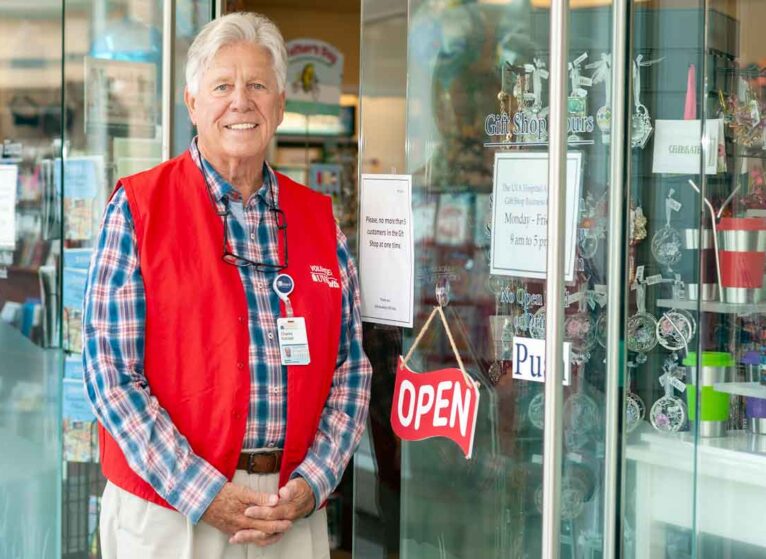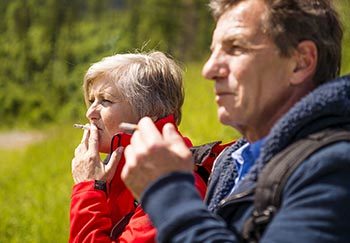Dave Kohstall, 74, knew he had the lungs of a smoker. He started smoking in elementary school. And smoked for decades. When his doctor said they should take a look inside his lungs, he resisted.
“I didn't want to have a picture of the inside. I knew what I'd done. I just really didn’t want to see it. I was scared,” he shares.
Perfect Candidate for CT Lung Cancer Screening
Get Screened for Lung Cancer If You:
- Are aged 50 - 80
- Smoked an average of 1 pack a day for 20 years
- Still smoke or quit within the past 15 years
- Have no symptoms (like unexplained cough or shortness of breath)
But Dave met the guidelines for someone who should definitely get screened. And it found lung cancer so early he was able to find a cure with a minimally invasive surgery. No radiation or chemotherapy needed.
Now he just comes back for followup CT scans to make sure the cancer doesn't come back. Watch his incredible journey.
DAVE KOHSTALL: I started stealing my dad's cigarettes at probably the third grade. Everybody smoked, so it was just a common thing. I never really thought about the consequences to it, and I never really considered the damage that it could do.
AIMEE STRONG: So Dave's smoking history was kind of typical for his age demographic. He wasn't super excited to have lung cancer screening done, and that's not an uncommon thing. Most people are really nervous about lung cancer screening.
DAVE KOHSTALL: Well, I made an appointment and the first person I saw was the nurse practitioner, Aimee Strong, and she sat down and informed me of all of what they've discovered. There was a cancerous growth in the lower lobe of my right lung and that was frightening. You know, I thought, what did you do to yourself?
AIMEE STRONG: So we were able to get Dave in to meet with one of our thoracic surgeons, Dr. Phil Carrott. And Dr. Carrott very quickly was able to get Dave to the operating room to actually take out that part of the lung where that cancer was living. The recovery from our minimally-invasive surgery is very quick. People are usually in the hospital a couple of nights. And for Dave, surgery was curative for him. He did not need to go on to get any sort of treatment afterwards. No chemotherapy, no radiation therapy. We simply follow him with CT scans of the chest every six months for two years. And as long as things look good, we'll get a scan once a year thereafter.
DAVE KOHSTALL: I go in there every six months wondering, is it coming back? Is it gone? But it's always so nice to have Dr. Carrott or Aimee sit there and say, 'Hey, it's all good.' And I have been cancer free for almost two years now. After the surgery, I was coming out of Dr. Carrott's office and I thought to myself, 'What is it that I could give back to this place?' Because I was elated that I had a chance to survive. And as I was walking out of the Cancer Center, I thought, Well, maybe I could be a volunteer. I wonder if they have volunteers? The thing I like most about volunteering is supporting people that are fearful, anxious and attempting to let them know that they're cared for here and that if there's anything they need, ask anyone that's employed here and we'll help them. I was hesitant to get screened for lung cancer because I was afraid to know what damage I had done. I attempt to suggest to people who smoke that they get a CT scan. Have the courage to take the initiative to find out what it is you need to know about your own health that might save your life.
Stigma & Fear Keeps People Away from Screening
“Unfortunately, only around 5.7% of people eligible for lung cancer screening get screened,” says Aimee Strong, a nurse practitioner and the program coordinator for the Lung Cancer Screening Program at UVA Health. The reason why many people opt out? The stigma around smoking and the fear of a cancer diagnosis.
“A lot of patients feel guilty about smoking. Or they’re afraid what screening will show them. These are some of the greatest barriers to screening people who really need it most,” says Strong.
For all these reasons, Dave resisted getting screened for lung cancer. Below, Dave shares in his own words:
- Why he finally decided to get tested
- How recovering from lung cancer surgery was easier than his joint replacement
- And how this experience changed his life for the better
Facing the Lung Damage From Smoking
I’ve been smoking probably from the time I was in the fourth or fifth grade. I used to steal my dad's cigarettes. I was smoking a pack a day in grade school. And smoked all the way through high school. I played sports through college. But after I got injured and couldn't play football anymore, I started medicating with drugs, and smoked a lot of pot, hash and cigars. I was a chimney, seriously. I'd smoke 2 to 3 packs of cigarettes a day.
I had quit several times on and off but had a nicotine addiction. I'm an alcoholic and a drug addict; I've been clean and sober for 46 years. But nicotine was the most difficult addiction I ever had.
At my initial meeting with Dr. [Lien] Dame at the [University Physicians] Orange clinic, I told her about the smoking. She said she needed to get a picture of my lungs, and I said, 'No, I’m not going to do that.'
But finally, I said, ‘OK, I’ll do it.’
Scan Reveals a Cancerous Growth & Cure

I went in and had the lung screening, and that first CT scan showed something. So I had to come back and do a PET scan. In the next day or 2, they told me it was a cancerous growth and I needed to be operated on right away.
They made me an appointment to see a lung surgeon at UVA Health named Philip Carrott. He’s from Kansas and I’m not a big Kansas fan. But he was alright after I got to meet him. He told me he was probably going to have to remove the lower lobe of my right lung. And they did.
They went in and removed that, and about 2 or 3 days later, I got out of the hospital. It was all pretty quick. The surgery was minimally invasive, so the recovery time was much less than my knee or shoulder replacement. After that, I had to go see an oncologist and he said, ‘Well, there's nothing there. It looks like Dr. Carrott got it all.’ So I didn’t have to do any chemotherapy. It’s amazing. Medicine today just blows my mind.
Gratitude Leads to Giving Back
I have no shortness of breath or anything like that. I walk every day, probably two miles with my dogs. I swim. I've tried to stay fit through the years thinking that that would ward off the cancer. Now I have to stay fit.
I feel very fortunate to have survived this cancer thing. I felt such a feeling of gratitude toward everybody — the nurses, the surgeon, the techs — everybody kept me focused and reduced my anxiety and reduced my fear so that I kept moving forward.
After my follow-up with the surgeon, something came to me. There’s a little statue on the campus of Antioch College with an inscription that says: ‘Be afraid to die until you've won some victory for humanity.’
So when I left the surgeon’s office, I thought, ‘Can I help win with this situation that I just went through?’ And I immediately walked over to the Volunteer Services office in the main hospital. And I said, ‘I want to look into volunteering.’ Now I’m doing it; I come in three days a week.
Don't Wait for Signs of Lung Cancer
Get screened with a CT scan.
‘Do Yourself a Favor & Get Screened for Lung Cancer’
It helps to do something for other people. And if we can help them win the cancer battle by pushing them to get screened, I’d do anything to get people to do that. It saved my life.
So if you’ve ever made unhealthy choices, I would say do yourself a favor. And get checked out and catch cancer while it’s in an early stage. Medicine today is very capable of treating that disease in your lungs. Don’t fear it. Go find out about it. It could save your life.


